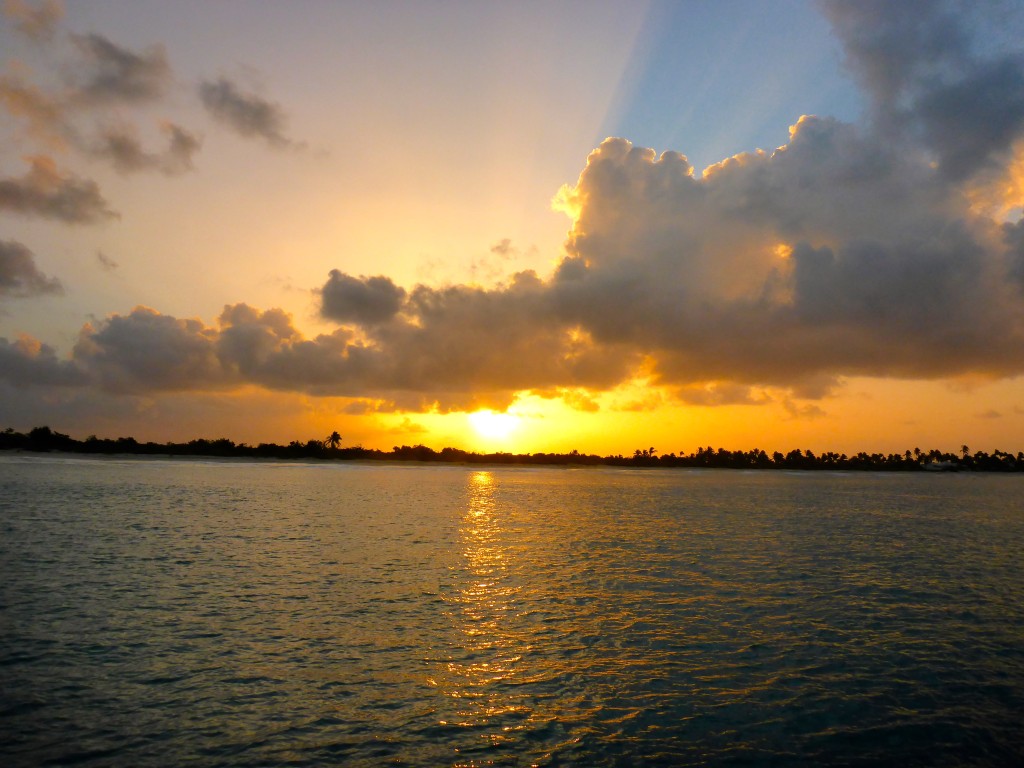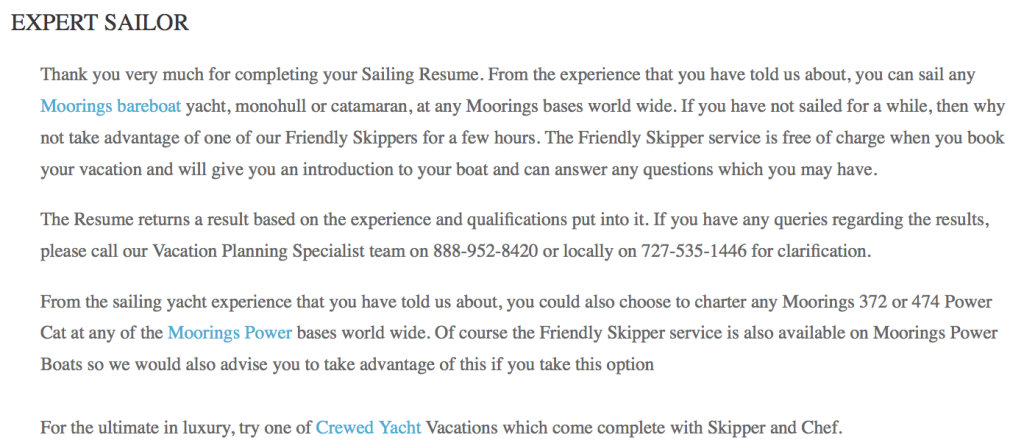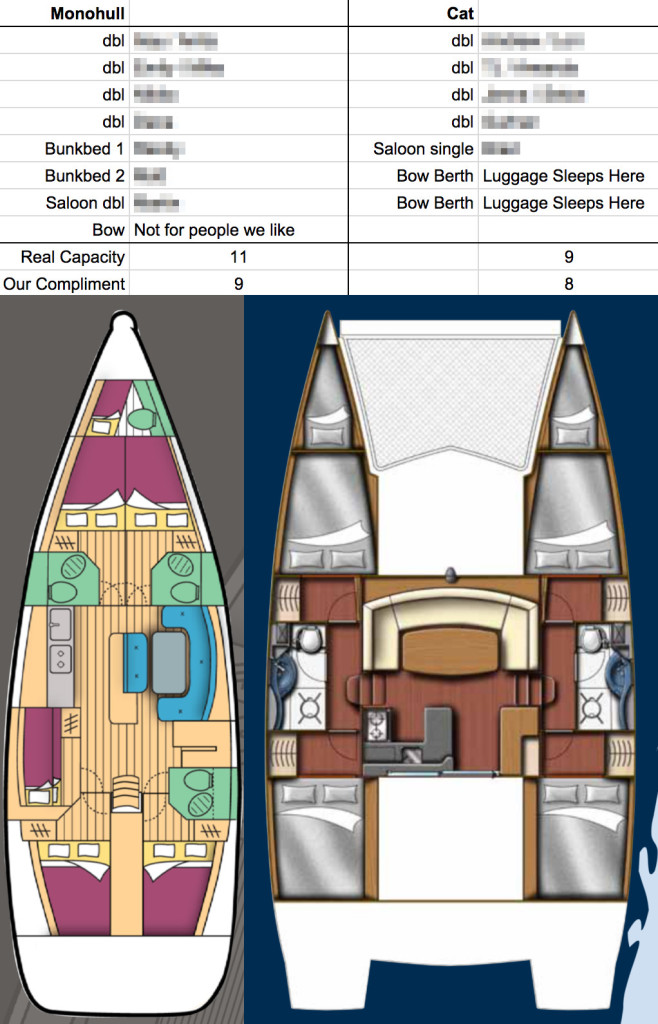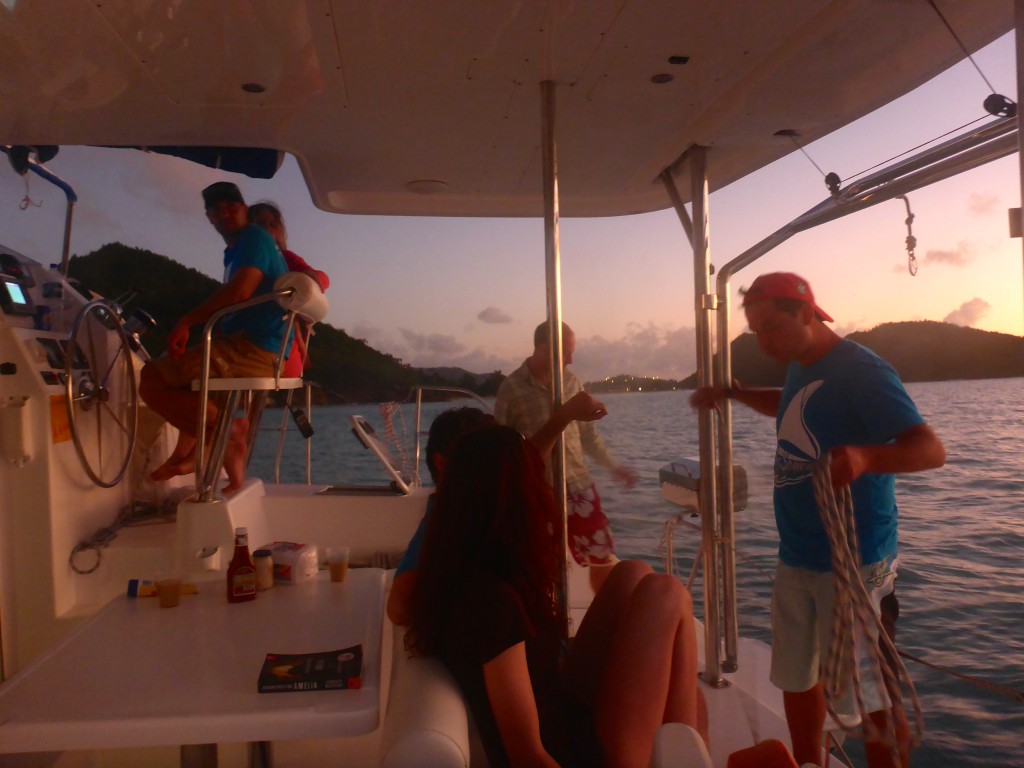As I stirred I was confused; the light streaming in through my hatch was coming from the wrong direction. From my bunk I could tell that we hadn’t swung overnight; I finally figured that the light streaming in wasn’t from the sunrise it was from the moonset! The skipper in me, however groggy, decided just before sunrise would be a good time to check the boat and anchor so up I went.

I’m often up for the sunrise when sleeping aboard. I leave behind the anti-rhythm of alarm clocks and packed after work weeknights in favor of the steady rhythm of the rising and setting sun. On deck I got my bearings: our anchored catamaran was still pointed at Coco point to the east. Our nine friends were still a few hundred yards off the starboard beam on their monohull; all seemed to be asleep. I turned on the instruments, snapped a few photos of the sunrise and listened for the sounds of stirring crew; all I heard was the waves in the distance, breaking ceaselessly on the beach.
After confirming all is well and that we had no need to get underway early I made my way back below feeling grateful and hopeful. I was grateful to be on a boat in Barbuda surrounded by so many friends and still having this beautiful moonset to myself. I was grateful to be able to share the rest of this trip with so many of my friends. I was hopeful that I’d help others achieve similar trips through this (no longer quite so) nascent website.

I also felt tired and quickly fell back asleep.
Bareboating Guide
This page is an overview of the “other things” that a competent big boat skipper will have to figure out to plan an amazing bareboat charter. There are so many sailing skills that one might need on a charter like this, skills that that SavvySalt will definitely get into, but for now we’ll start with the planning component of a bareboat charter. Having just finished an amazing charter the work that went into it is fresh in my mind.1I also started taking notes for this series before we started planning the … Continue reading
Prerequisites: Sailing Skills
This guide is for sailors with their ASA Bareboat Cruising, US Sailing Bareboat Cruising or equivalent experience.
When I recommend the ratings, rather than putting those classes on a pedestal, instead use them as an opportunity to evaluate your own abilities. Think about the decisions you’d make; if they differ from the other crew or instructor determine if they’ve chosen a different option or if you would have made a mistake. You have to decide whether you’re ready to be responsible for a boat when that boat isn’t crewed by a bunch of other sailors and an instructor. Ask the instructor and other sailors for feedback but ultimately you have to make the final decision. I’ve got a friend with the ASA Bareboat rating and she says “the most important thing I learned getting this rating is that I’ll never skipper a bareboat”.
Equivalent experience is also a similar chance to evaluate your skills. If you’d be comfortable sailing the boat for a week as the most experienced sailor aboard you’re well on your way.
Again, ultimately, the decision to skipper a bareboat is yours to make. Hopefully reading this guide and other articles on SavvySalt give you more of an idea what a bareboat is about. I also suggest you check out this video series we created on learning to bareboat charter. Still, there is no substitute for time as the skipper of a moderately sized yacht for gaining the experience and confidence to successfully skipper your own bareboat charter.
Qualified on paper
You’ll probably have to fill out a sailing resume like one of these:
- Sunsail Sailing Resume (instant feedback)
- Moorings Sailing Resume (instant feedback)
- Horizon Yacht Charters Sailing Resume (PDF)
- Dream Yacht Charters Forms Page (Word Docs)
The instant feedback on some forms is great because you can quickly know where you stand:

But the final determination is up to you, the charter company could merely be fulfilling an insurance requirement when they ask you about your experience.
Usually, there are non-negotiable paperwork requirements. Oftentimes these are travel related (passports) but some are sailing specific; you don’t need to fulfill them yet but it’s good to be aware of them.
Some places have odd requirements that are as easy to fulfill as they are to forget about. In Croatia you need a VHF operator certificate to charter; in the USA you simply need to fill out a web form and pay a few dollars some weeks in advance to meet that requirement. Last minute that VHF certificate would be a showstopper.
Most charter companies will verify your credentials over the internet but make sure that’s all taken care of before you start booking plane tickets!
When and Where?
Perhaps you’ve got somewhere in mind. If you’re like me you’ve got a whole list of places that you’d eventually like to sail. If your ideas are like mine they’re larger areas than a charter will let you explore; like the Caribbean, Greece or Turkey (each of which has multiple charter bases).
If you’re looking for ideas you can checkout the websites of some of the bigger charter companies like The Moorings and Sunsail to start getting an idea of where you’d like to charter. The locations and suggested itineraries of the charter bases will have hints about the sailing logistics.
Once you have some destinations in mind, perhaps even having a specific base in mind, it’s time to start researching when you’d like to visit. Beyond what you’ll find on the charter company websites, Wikipedia often has good information about the seasons in a given area (ex: Athens) but doesn’t usually cover sailing conditions. Weatherspark has some really nice climate summary data broken down month to month which does cover the wind but not the seas. In this post I describe the research used to figure out where my friends and I would take our second Caribbean bareboat charter. You can even find videos of bareboat charterers on youtube and really start to get a sense for a place. Shameless plug 😛
Even this early in the process you can start looking at potential passages and whether or not you plan to undertake them. In this passage evaluation post I provide an example of such an assessment.
If this is overwhelming and you’re new to big boat sailing I suggest you complete the ASA bareboat class and then consider a first bareboat charter in the British Virgin Islands.
Herding Cats
Once you’ve got a when and where you’ll be able to approximate a price for the trip. Of course, figuring out price per person depends on which boat(s?) you get which also depends on how many people you wind up chartering with. I like to get an approximate number of people before booking. It’s time to whip up an email including an approximate price per person, destination, approximate dates, an awesome sailing video to help people make their minds, a refund policy and shop it around.
On our last trip where we had 17 people signed up we decided to have people get their shares on the way before we booked. So we priced out an option for 7 nights with a split of a fewer than 17 people for the boats on a given week. Due to boat availability we gave people a range of days (the last week in January to the last week in February). Once people really committed (checks in the mail) boat availability led us to a 8 night Saturday to Sunday booking where we still wound up refunding each of our crew $24. Theoretically it wouldn’t even require an additional vacation day of anyone.
Stray Cats
People are going to back out. I’ve done 3 bareboat charters of 13, 5 and 17 people. The only one without any last minute crew changes was the 5 person trip. After the first trip with 13 people and a lot of crew change drama we came up with the following refund policy as a part of our Bareboat Crew FAQ:
The {money each paid for the trip} is non-refundable. If the trip is cancelled all money refunded by the charter company will be returned. If you can’t make it you will need to find a person to buy your spot. We can help you with this but ultimately it is your responsibility. The person taking your spot will pay you and not the trip organizers.
I strongly encourage you to have a refund policy similar to this one along with collecting money up front. It can save you a bunch of headache later on if people who change their minds know that they’re responsible for finding a replacement; even if you wind up doing all the work to find one.
I’ve never wound up having anyone pay for a trip that they didn’t come on, nor have I ever had to ask my crew to fund a non-attendee’s share. I have, however, spent months scrambling to find replacements for people who bailed; it was stressful time for me and an awkward position to be in. On the other hand, it worked out OK and during the uncomfortable recruiting effort I wound up meeting and befriending a bunch of cool sailors as well as finding two awesome young women who wanted to give chartering a try; they had an awesome time doing so and we’ve been sailing together many times since! All’s well that ends well I suppose.
The Booking
Once you’ve selected when and where to bareboat most of the charter companies make the rest of the process fairly easy and it can be done on their website, via email or over the phone. In case you’re new to bareboat chartering I’d like to share some tips I’ve picked up along the way.
Make sure you realistically assess the boat’s accommodations and your tolerance of those accommodations; just because it says it sleeps 8 it really doesn’t mean you can fit 8 people. Take a look at the layout diagram and figure out which berths are singles, which are doubles and which are suitable only for small children or large suitcases. In my experience the charter company representatives will be honest about this with you; they want you to be comfortable. They may be incentivized to upsell you. I want to say a boat is a small space to spend a week so err on the side of fewer people and more room but I’ve almost always filled my boats to capacity. I’ve had an awesome week with 7 friends on a 37’ monohull.
I think it’s worthwhile to grab your crew list and go through the exercise of assigning people to berths before you book any boats. This way you can get a sense of how cramped the boat will be and give some thought to who will be comfortable where. When we did the Antigua trip we used this approximation to assign people to boats and then left the final choosing of berths to the crews once they arrived and actually saw the spaces aboard the boats. We spent some time on the phone with Sunsail to determine which berths were suitable for adults; they gave us good information. Here’s what we wound up with:

Then check back with your initial research. Are there any boat specs that you want to make sure are met? Oftentimes a foot or two of draft can make a big difference in where you’re able to take the boat, make sure you take that into consideration while booking. Is there a maximum size boat you’re comfortable med-mooring? Are you accustomed to having a bow thruster in order to maneuver? Does the boat you’re looking at have all chain rode and a windlass? Besides length overall, the charter companies tend to only have on hand boats that are suitable for the areas they’re allowed to sail. Still, some of these subtle differences can make a big difference on the quality of your vacation.
Finally, double check the credentials the skippers will need and set a reminder to bring them with you.
You can look for deals, coordinate calendars, coordinate payments and so much more but that is just like any vacation ashore so you’re on your own with all that. Good luck!
Additional Prep
Once you’re booked and money is collected there’s nothing else you have to do; you can figure out everything once you’ve arrived. There is, however, a lot you can do to ensure everyone has the best time possible.
Get and Share a Cruising Guide
I always buy a cruising guide of the area. If there are multiple cruising guides consider purchasing more than one. Get at least one print edition because you’ll be using it underway aboard and it’s easier to share a book amongst the crew beforehand than it is an electronic book.
I’ve found it’s useful to get the cruising guide as soon as you’ve booked, give it a once over, take some snapshots of anything you think you’ll need for planning and then pass it on to the next crew member. This way you wind up with a lot more opinions about what to do once you’re there but having the crew briefed on the area, it’s hazards and attractions makes the trip go more smoothly.
Before you arrive you can do some “draft” planning. Solicit ideas from the whole crew, especially those who’ve had a turn at the cruising guide. It’s hard to get the charter company to divulge all of the details you’d need for more specific planning before the briefing that they require you attend after arriving. There is also the weather to consider. I’ve heard it said that all planning on a sailboat is written in sand at low tide; treat your “plan” as a list of ideas instead of an itinerary and you’re sure to have a more successful trip.
Provisioning
Provisioning is always a fair amount of work and bareboat provisioning has it’s own unique set of challenges and opportunities. First you have to choose how you’d like to provision, I detail your options here. Step two is figuring out the nuances of your crew and the trip you’ve chosen to get a rough idea what you need for provisions which this article will help you with. The provisioning itself is up to you but this final checklist should help you avoid forgetting anything critical!
It’s likely you can delegate provisioning; in fact provisioning is probably the easiest task to delegate that we’ve talked about in this article. In my group we always have someone who isn’t the primary skipper in charge of the provisioning (though oftentimes the skippers keep a watchful eye if the provisioning is done in advance). It’s good to delegate provisioning to one responsible party; it’s troublesome having too many cooks in the galley…
Prepping the crew
The real trick with prepping your crew is to choose the correct crew in the first place 🙂 I tell those new to cruising to think of the boat as luxurious campsite instead of a really cramped hotel room.
Remember, many of your crew don’t know what they don’t know about this kind of trip; you must use your experience to decide what to share with them. I like to send them my packing list a few weeks before the charter in case they want to purchase a few things off the list. I also like to send out this article to start to set expectations about what makes life aboard different than life ashore (besides watching sunrise and sunset over the water and being surrounded by the worlds largest infinity pool).

Once again I think there is no substitute for time aboard so I try to make opportunities for inexperienced crew to join a day sail or two whenever possible. Yet another reason I have to get on the water 🙂
The last essential crew prep is usually an email detailing how to get from the airport to the charter base and instructions on where to meet near the charter base. I also encourage everyone to connect via WhatsApp before leaving their home country (setup is much more complicated once you’re international; learned that one the hard way). That makes communication much easier once we’ve arrived.
That’s all for now
After all this planning you still have the responsibility of skippering the boat once you begin the trip. I’m sure you’ll have preparations that I didn’t think of or haven’t been relevant to the bareboat charters I’ve been on. This guide, however, should be a good place to start for anyone planning a bareboat charter.
Subscribe below and you’ll be updated when I fill in some of the missing links above above. Fair winds and following seas!
References
| ↑1 | I also started taking notes for this series before we started planning the charter 🙂 |
|---|
Leave a Reply